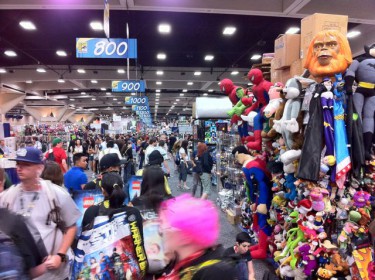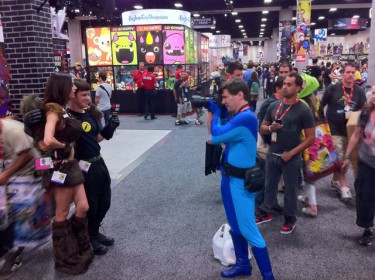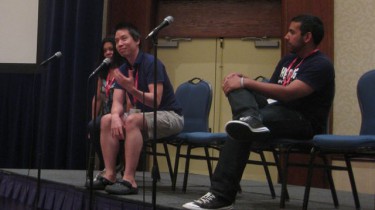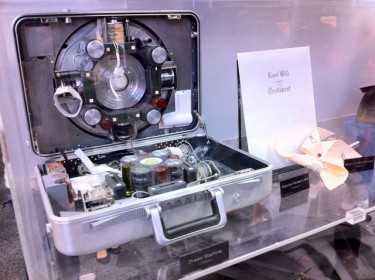 Back to selection
Back to selection
An Independent Filmmaker at Comic-Con
Last month, I travelled to San Diego to spend three days at Comic-Con, the massive annual gathering of fans of sci-fi, fantasy, horror, comics and related pop culture. It was my first time to the event and I was there to screen my new sci-fi short Digital Antiquities at the Comic-Con Independent Film Festival. I’ve been to many festivals with my films, but Comic-Con was an experience like no other. The scale of the event and passion of the fans were overwhelming, and as an indie filmmaker I found the experience both incredibly inspiring and deeply humbling.
DIGITAL ANTIQUITIES

In early January, I delivered the final cut of my new short film Digital Antiquities. Commissioned by ITVS, the film was part of season two of FUTURESTATES, an online series of sci-fi shorts about America’s future (that’s a picture of me on set). This season premiered online in March, showcasing ten films from a diverse group of emerging indie filmmakers including Barry Jenkins, Mia Trachinger, Kimi Takesue, and A. Sayeeda Clarke, among others. (If you’re reading this on the Filmmaker website, you’ve no doubt already seen Plastic Bag, Ramin Bahrani’s 2010 viral short featuring Werner Herzog; it’s by far the best-known FUTURESTATES
film.)
I’m a self-taught filmmaker and I work at a full-time day job at a government agency. I make my short films during nights, weekends, and vacations. Since 2005 I’ve had a short on the festival circuit almost every year, all self-funded and produced, with budgets ranging from $94 to $5,500. I’ve been lucky that my films have found receptive audiences on the Asian American film festival circuit, as well as at bigger fests like Slamdance, SXSW, Sarasota, and Rhode Island. Because I was too old and too poor to enroll in film school, I had to learn the craft and business solely from shooting shorts and screening them at festivals. This isn’t a path for everyone, but I’m grateful for the friends I’ve made and the things I’ve learned along the way.
Digital Antiquities is my sixth short film and by far my biggest project to date. I’d always wanted to do a sci-fi film, but found it’s a tough genre to tackle when you’re working at the no-budget level. Most of my earliest movie memories are of classic sci-fi films; to this day they remain among my all-time favorites and continue to inspire my work. (Note to parents: if you let your fifth grader repeatedly watch THX-1138 and Alien unsupervised, you’ve got nobody to blame but yourself for what results.)

So when the FUTURESTATES commission came along I geeked out big time, creating an ambitious (some might say crazy) production that involved extensive visual effects, elaborate sets, stunts, special effects, several hundred pounds of electronic waste, and (of course) lawyers. Over a year in the making, this 15-minute short couldn’t have been accomplished without the small army of fantastically dedicated crew and cast my producer Diane Houslin (Yelling to the Sky) and I were able to recruit. Digital Antiquitieswas an incredible challenge to make, and I hope that a lot of people watch and enjoy it. It’s probably the last short I’ll make before embarking on the feature projects I plan to start making next year.
Because Digital Antiquities would be distributed online (and also for budgetary reasons) I didn’t plan for much of a festival run. I submitted the film to just a handful of festivals I’d screened at before and a few genre fests that I thought might be receptive to a quirky sci-fi short. One of the latter was the Comic-Con Independent Film Festival, which takes place each July in San Diego as part of the (far larger) convention. To my surprise and delight, Comic-Con accepted the film.
THE COMIC-CON EXPERIENCE

San Diego Comic-Con is a massive annual event that in recent years has become the place where Hollywood shows off its upcoming genre properties to hardcore fans. (As a small-time indie filmmaker, it feels really weird and pretentious to use an industry phrase like “genre property.” But it’s hard to find another term that accurately describes the sheer scale and commercial exploitation potential of the majority of movies and shows that are showcased here. This ain’t the Anthology, folks.) Attendees line up hours in advance to get into panel discussions for sneak peaks at upcoming films and TV shows, usually accompanied by their high-profile creators. When you read about Comic-Con in the media, you’re usually hearing news that comes out of these panels. (Spielberg & Jackson reveal first Tintin clips! Ridley Scott appears via video from Iceland set of Prometheus! Coppola shows off Twixtfootage!)
But the panels are just one part of the Comic-Con experience. The heart of the event takes place downstairs from the panels in the massive exhibit hall of the San Diego Convention Center. Here in a giant space over a half-mile long are hundreds of exhibit booths of all sizes, from the sprawling Star Wars and Fox structures to the small cubicles occupied by indie vendors and artists. Virtually all of Comic-Con’s 125,000 attendees (a number limited by space and fire codes, not demand) spent some part of their visit here and the crowding can get quite severe.
The exhibition hall is the Main Street of Comic-Con. It’s a marketplace, a riot of commerce and art, an explosion of images and corporate branding on every surface; a veritable NASCAR for nerds. At the Legendary Pictures booth, you can leer at the Dream Machine suitcase from Inception and gawk at Batman’s Tumbler from The Dark Knight. (In case you are unclear about how large Christopher Nolan looms over this event, the GRE analogy is Comic-Con is to Christopher Nolan as NYC is to Brooklyn.) Over at Hasbro, only a short wait in line separates you from taking a seat in Emperor Palpatine’s throne from Star Wars. Elsewhere, you can get a back rub from a masseuse dressed like Wonder Woman, buy a photo-op with Billy Dee Williams, and purchase original artwork from dozens of illustrators both known and unknown. At a model-maker’s booth, I overheard a conversation about warp engine nacelles and realized that everyone else within earshot probably had an opinion too.

And yes, cosplay. I’d read about it, but never seen it in person until Comic-Con. The ubiquitous images of Star Wars-clad attendees you see every year are no exaggeration; a lot of folks come in costume, and a clearly lot of time was spent making those costumes. It’s both baffling and deliriously joyful: middle-aged men in superhero tights, twenty-something women in anime battle gear, six-year-old Boba Fetts — all eager to pose for photos. Nobody at Comic-Con is camera shy.
From a distance, the cosplay is easy to ridicule and dismiss as something strictly for the fanatical. Indeed, there is a strong undercurrent of obsession at Comic-Con that’s no doubt been the subject of many doctoral dissertations. But when you’re on the exhibition floor and suddenly find yourself surrounded by a group of thirty- and forty-something regular guys dressed like the Avengers (but much doughier), all ironic detachment disappears and you just get caught up in the fun. Masked strangers strike heroic poses, cameras snap away, and everyone’s having a great time. Even the vaguely creepy cultural and gender studies-worthy stuff somehow seems innocent and good-natured in that crowded exhibit hall.
The key to this normalizing effect is the sheer size of Comic-Con, both in attendance and interest. The all-ages crowd and ubiquitous big-name corporate presence all serve to reassure visitors that it’s perfectly normal to dress up, play, and (of course) buy. Comic-Con may still have its nerdy reputation, but standing there in a sea of thousands of people and surrounded by so much Hollywood product, it doesn’t feel marginal in any way. And those wearing costumes, you eventually realize, are only dressing up as characters from the biggest popular entertainments our civilization has ever created.
THE COMIC-CON INDEPENDENT FILM FESTIVAL
If the scene at the exhibit hall was all about how big popular culture can get, the screenings next door at the Independent Film Festival (IFF) were a nod to how humble its roots could be. This year’s IFF included 49 shorts in a variety of genres, including action/adventure, sci-fi, horror, animation, comedy, and documentary. The IFF also hosted several panels aimed at the indie filmmaker on subjects like microbudget post-production and distribution.

We’d heard in advance from friends who’d attended previously that the IFF was a very small, not well-known part of Comic-Con. Expectations in check, we were were relieved to see about 30 people in attendance when Digital Antiquities started to roll. It was a respectably-sized crowd compared to many of the smaller fests I’ve been to, but felt tiny in the sea of 300 seats. Nonetheless, there was much to be thankful for: though screening off a DVD, the film looked and sounded good. The audience seemed to pay attention throughout the movie. When the lights came up, there was applause and I was joined on stage for the Q&A by Diane my producer and Karim Ahmad of ITVS, who is series manager for FUTURESTATES. We got good questions from the audience and hopefully encouraged them to spread the word about our film.
Judging by the other IFF screenings I attended, our festival experience was typical: excellent A/V, small but attentive audiences, lively Q&A with a crowd that knows and loves movies. Comic-Con IFF isn’t yet well known, but deserves a look by indie filmmakers with shorts heading to the festival circuit.
As IFF directors, we knew we were merely little fish in a giant pond. Nonetheless, every indie filmmaker I spoke with seemed as genuinely honored and highly excited to be part of Comic-Con as I was. (And yes, some of them were wearing costumes too.) Many saw their short films as calling cards for feature-length versions. Some had never screened at a festival before. All of us, however, harbored dreams of showing our future work at the industry panels next door one day. I’m sure several of us will.
“YOU MUSTN’T BE AFRAID TO DREAM A LITTLE BIGGER, DARLING” – Eames, Inception

As an indie filmmaker firmly planted in the DIY and microbudget mindset (I subscribe to Filmmaker, after all), I thought I had a pretty clear-eyed, pragmatic view of what my future in independent filmmaking might be like. Though I haven’t yet made a feature, I’ve learned a lot from watching my friends and others take their microbudget films around the festival circuit and through the various distribution channels available to them. From this and other sources, I saw a path for my own filmmaking: keeping things financially sustainable, but creatively ambitious, with the simple goal of producing work continuously.
If this dream seemed a little prosaic, it was not without good reason; too many stories of independent filmmakers crashing and burning (not the fate of my friends, fortunately) had made me leery of expecting too much else from the indie life. I’d been to Park City and Austin with my shorts and I saw the what my feature brethren were aiming for: win the Grand Jury Prize, sell the movie, get money to make another movie. Getting that far was more than 99.9% of indies ever got and to want more was lunacy. I adopted it as my own goal; as long as I could make movies that said what I wanted to say, at some regular interval, that would be enough. Everything else would be gravy.
As a practical way to make movies, my plan was still sound. But it was missing a critical element: the sustaining belief that my work could — and should — connect with a much larger audience than the indie world. I’d hatched a plan I thought would protect and sustain my ability to express myself through my films, but forgot the other half of why we make movies: to connect with others on the largest scale we can.
Comic-Con inspired me to dream bigger. Standing there in a room with tens of thousands of movie fans — a single crowd bigger than the entire lifetime audience of most independent films — I realized I’d set my sights too low. Previously, I couldn’t see any connection between my indie aspirations and popular acceptance. Now, I can’t see why I wouldn’t want my work to be in the realm of pop culture as long as I retain my voice.
I’m still indie to the core and won’t abandon its aesthetics or approaches (frugality is in my DNA), but Comic-Con made me understand that the ethos of “small is beautiful” wasn’t meant to be a limit to ambition, but a foundation. Big could be beautiful as well, especially if it means having more of an impact on the dialogue of our times. In other words, winning the Palme d’Or is great, but people dressing up like your characters is greater.
For me, the allure of bigness is not about money, but impact. If Comic-Con is a celebration of the biggest cultural works of our civilization, then indies have to be at that party — in the big exhibit hall, not just next door. We have to be part of the conversation.
It’s not an impossible hope: for proof, I had to look no further than the prop Dream Machine locked behind glass at the Legendary booth. After all, before Mr. Nolan created Inception, he was an indie too.
J.P. Chan is a self-taught filmmaker and playwright living in New York City. His short films have screened at film festivals around the world including Slamdance, SXSW, Tribeca, and Comic-Con. He is a member of the Ma-Yi Writers Lab, holds a graduate degree in urban planning from NYU, and was born in New Jersey to working-class immigrant parents. You can follow him on Twitter: @JPChan.
